Both private citizens and businesses are becoming increasingly concerned about remote hacking. Cybercriminals’ techniques and methods for Stop a Remote Hacker from accessing devices and data have advanced due to the rise in connected devices and the ensuing expansion of the attack surface.
In this post, we’ll look at a few tried-and-true techniques for thwarting and blocking remote hacking attempts and offer practical advice on how to Stop a Remote Hacker on your devices and networks against fraud. (Stop a Remote Hacker)
The Top 5 Ways to Stop a Remote Hacker are listed below.
Increase Software Quality:
Here are five original techniques to improve your security posture and software quality:
- Perform Regular Code Reviews: Regular code reviews are essential for spotting and resolving software issues before attackers can take advantage of them. Experienced developers with an eye for detail should conduct these assessments, and they should be recorded to maintain responsibility.
- Create a Robust Testing Strategy: Finding and fixing software vulnerabilities requires a robust testing strategy. This should comprise thorough testing that examines every area of your software’s functionality, including user authentication, data input validation, and error handling.
- Establish a safe Development Process: Establishing a safe development process can assist in avoiding the initial introduction of vulnerabilities into your product. Access controls, secure coding techniques, and ongoing security audits should all be used in this.
- Make Use of Automated Testing Techniques: Before software is released, defects and vulnerabilities can be found using automated testing techniques. To find and fix weaknesses in your software, you can make use of methods like static analysis, dynamic analysis, and penetration testing.
- Create a Process for Vulnerability Management: Implementing a process for vulnerability management can assist in locating and addressing software issues. Regular vulnerability scans, an evaluation of the risks connected to the vulnerabilities found, and the prioritizing of remedial efforts should all be part of this.
You may greatly improve the quality of your software and strengthen your security posture by adhering to these five original procedures, lowering the chance of security breaches and data breaches.
Keep in mind that maintaining software quality and security calls for a dedication to constant quality controls and industry best practices throughout the software development lifecycle.
Utilize secure passwords:
Make your passwords secure and unique using these 5 tips: (Stop a Remote Hacker)

- Make passwords at least 8 characters long, with a mix of uppercase and lowercase letters, numbers, and special characters. Avoid commonly used passwords like “password” or “123456”.
- Use a different password for each of your online accounts, and don’t reuse passwords across multiple accounts. Consider utilizing a password manager when establishing and storing complex passwords.
- Periodically, change your passwords, particularly if there’s been a security breach on a website or service you use.
- Don’t share your passwords with anyone else, whether it’s a friend, family member, or colleague. Don’t save your passwords in plain text on your computer or other devices, including note apps, spreadsheets, and browsers.
- Consider using two-factor authentication (2FA) for added security, especially for important accounts, like bank accounts, emails, and social media. With 2FA, you’ll need to enter both your password and a randomly generated code sent to your phone or email to access your account.
By implementing these strategies, you can secure your online account credentials and reduce the risk of being hacked or having your personal information stolen. (Stop a Remote Hacker)
Remember that strong passwords are only one piece of the puzzle when it comes to online security – it’s also important to be vigilant about the websites you use, the software you download, and the email attachments you open.
Protect Your Wi-Fi:
Safeguard Your Wi-Fi: Keeping your organization secure requires a few measures, including: (Stop a Remote Hacker)

- Changing default Wi
- Passwords: Your switch might accompany a default secret phrase that is effectively guessable. To safeguard your organization, you ought to change the default secret key to major areas of strength for a, one and keep it secure.
- Encode Wi-Fi organization: Guarantee that your WiFi is safeguarded through encryption conventions like WPA and WPA2. These conventions forestall unapproved admittance to your organization.
- Forward-thinking switch: Stay up with the latest to guarantee security refreshes are applied. Check consistently for firmware refreshes and introduce them right away if accessible.
- Debilitated remote access: Cripple any remote access settings in your switch’s administrator board. Remote access can permit programmers to get to your organization.
- Visitor organization: Set up a different visitor network for guests. This can assist with forestalling unapproved admittance to your essential organization and safeguard your delicate information.
- Conceal Wi-Fi network data: Conceal your Wi-Fi organization’s SSID (Administration Set Identifier) by setting it to imperceptible. This can keep programmers from effectively distinguishing and getting to your organization.
You may strengthen the security of your Wi-Fi network and greatly reduce the likelihood of unwanted data breaches or cyberattacks originating from your network by putting these watchful tactics into practice.
Apply a VPN:
Utilizing a Virtual Private Network (VPN) proves to be an excellent means of fortifying your Wi-Fi network and ensuring the security of your online activities. When you employ a VPN, your internet traffic undergoes encryption and is directed to a VPN server, which subsequently channels your traffic to its intended destination.

This essentially means that your online activities remain shielded from prying eyes, including third parties and your Internet Service Provider (ISP), effectively thwarting potential (Stop a Remote Hacker).
Moreover, a VPN offers the advantage of altering your IP address, enhancing your online anonymity. By changing your IP address, you can conceal your real location, making it considerably more challenging for cybercriminals to track your online behavior.
To utilize a VPN, you want to pursue a VPN administration and introduce the VPN programming on your gadgets. Here are the means for setting up a VPN:
- Pick a VPN supplier: There are numerous VPN suppliers accessible, and you ought to pick one that offers solid encryption, quick paces, and various server areas.
- Introduce the product: Whenever you’ve picked a supplier, you’ll have to introduce VPN programming on your gadgets. The particular advances will rely upon the VPN supplier you pick.
- Interface with a server: Interface your gadgets to the VPN server utilizing the VPN programming. You can pick the server area depending on your requirements and inclinations.
Utilizing a VPN empowers you to get your web traffic as well as your Wi-Fi organization. A VPN is especially valuable while voyaging abroad or using public Wi-Fi networks since it could safeguard your security and conceal your web-based actions. (Stop a Remote Hacker)
Switch on two-factor authentication:
Two-factor verification, otherwise called 2FA, is a safety effort that requires two types of distinguishing proof, (for example, a secret key and a 6-digit code) to sign in to a record. (Stop a Remote Hacker) By empowering 2FA on your web-based accounts, you can add a layer of safety and safeguard yourself from a wide assortment of network protection dangers.
To empower 2FA, you can make the following strides:
- Check if the help you have any desire to utilize offers 2FA: numerous web-based administrations offer 2FA, and you can check if the ones you use do so by thoroughly searching in their settings or FAQ area.
- Empower 2FA: Whenever you’ve found a help that offers 2FA, you can empower it by going to your record settings and seeing it as the “Two-factor validation” choice.
- Pick your verification technique: Most administrations offer different 2FA strategies, like SMS, email, or authenticator applications, so pick the strategy that turns out best for you.
- Set up your 2FA: Adhere to the directions offered by the support to set up your 2FA, then set up a reinforcement strategy for recuperation on the off chance that you lose admittance to your essential technique.
By empowering 2FA on your web-based accounts, you can safeguard yourself and your information from programmers, phishing tricks, and other network safety dangers. This is particularly significant for touchy records, for example, your email or financial balance.
The threat of remote hacking is increasing, and there are many ways for hackers to gain access to devices and data. (Stop a Remote Hacker) It’s critical to develop a tiered strategy for cybersecurity and be aware of these attack vectors to protect oneself.
Using firewalls, endpoint security, secure access systems, and user education and awareness initiatives are some examples of how to do this. Furthermore, it’s crucial to comprehend the many kinds of firewalls, including network-based and host-based firewalls, and to set them up to let or block particular sorts of traffic according to pre-established criteria. (Stop a Remote Hacker)
Conclusion:
Stop a Remote Hacker your computerized resources and security from remote programmers should be your top priority in today’s visibly networked world.
By following the fundamental advancements outlined above, such as utilizing key points of strength, enabling two-factor verification, remaining current, putting in place firewalls and interruption identification systems, and educating yourself and your team about network protection best practices, you can completely reduce the risk of becoming a victim of remote hacking attempts.
Keeping ahead of programmers requires keeping in mind that network security is an ongoing endeavor and using prudence. You may significantly increase your computer security and reduce the risks by adopting a proactive approach to protecting your online presence and consistently watching for potential threats.
The Essential Guide to Hacking Viruses
What is a remote hacker, and why should I be concerned about them?
A remote hacker is someone who tries to gain unauthorized access to your computer or network from a distant location, typically over the Internet. You should be concerned because they can steal your personal information, compromise your online accounts, or even damage your system. (Stop a Remote Hacker)
How can I protect my computer from remote hackers?
To protect your computer, you can use strong, unique passwords, enable two-factor authentication, keep your software updated, and use firewalls and intrusion detection systems. Additionally, educating yourself and your team about cybersecurity best practices is essential. (Stop a Remote Hacker)
What is two-factor authentication (2FA), and why is it important?
2FA adds an extra layer of security by requiring two forms of verification before granting access to an account. It’s important because even if a hacker obtains your password, they won’t be able to access your account without the second factor, such as a code sent to your mobile device.
How often should I update my software and applications?
Regularly update your software and applications as soon as updates become available. Hackers often exploit known vulnerabilities in outdated software, so staying up-to-date is crucial.
What should I do if I suspect my computer has been hacked remotely?
If you suspect a remote hack, disconnect your device from the internet immediately Stop a Remote Hacker from further access. Change your passwords, run antivirus scans, and consider seeking help from a cybersecurity professional to assess and mitigate the damage.
Are there any tools or software to help protect against remote hackers?
Yes, there are various cybersecurity tools and antivirus software available that can help detect and stop Remote Hacker attempts. It’s important to research and choose reputable solutions that fit your specific needs.
How can I stay updated on the latest cybersecurity threats and best practices?
Stay informed by following cybersecurity news sources, attending webinars or workshops, and participating in online forums or communities dedicated to cybersecurity. Regularly educating yourself is key to staying ahead of potential threats.


2 thoughts on “Top 5 Ways to Stop a Remote Hacker”